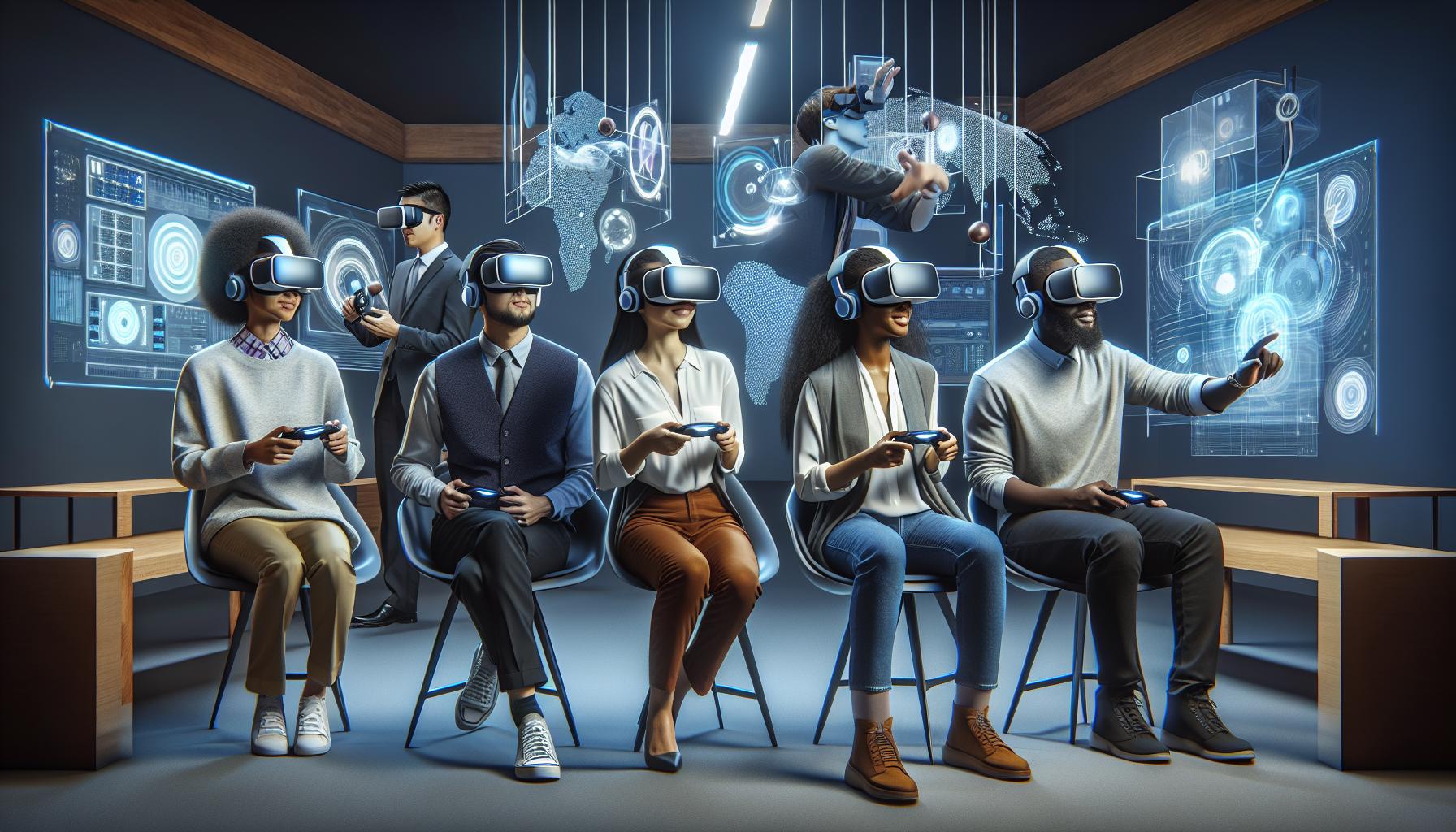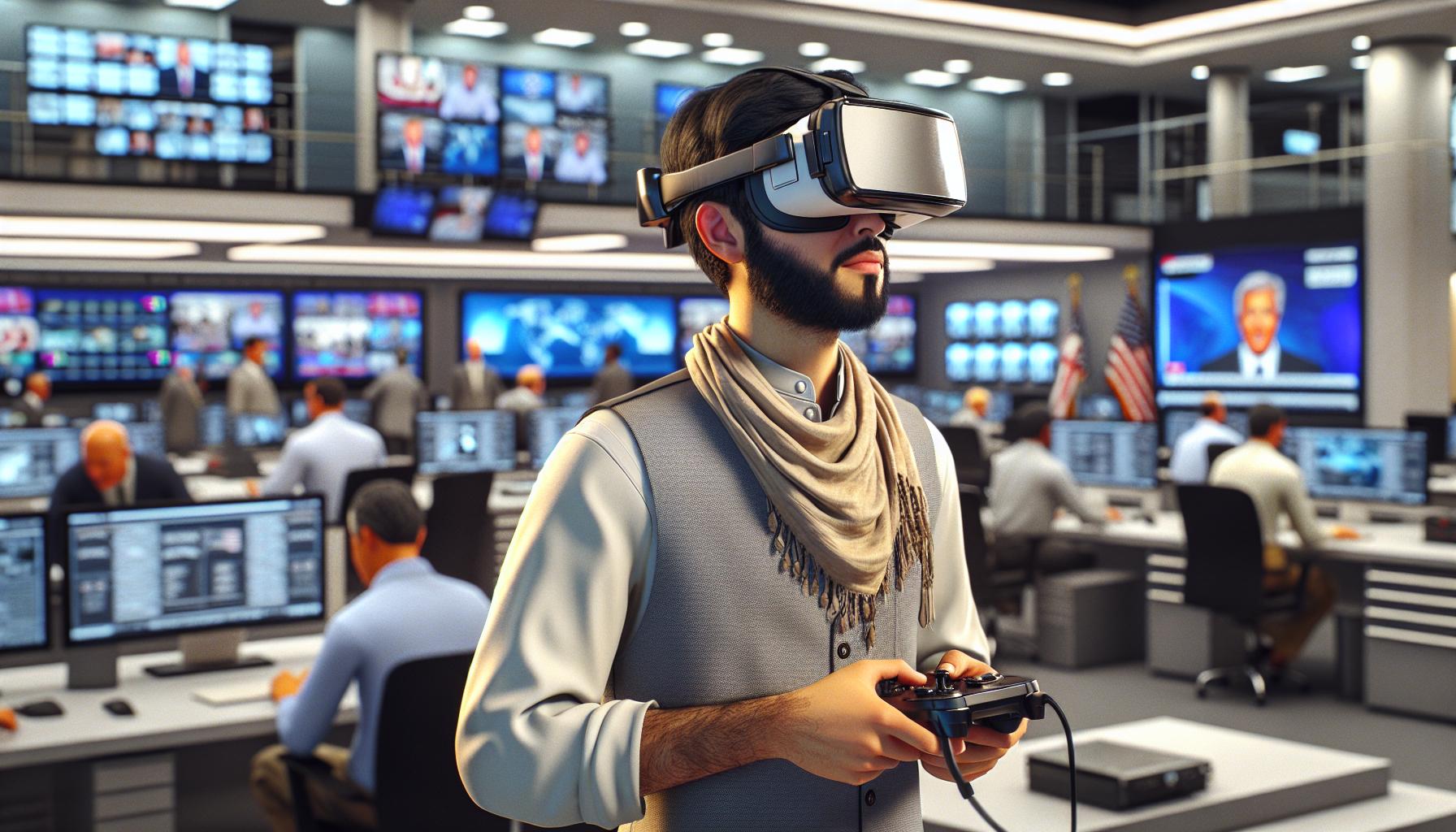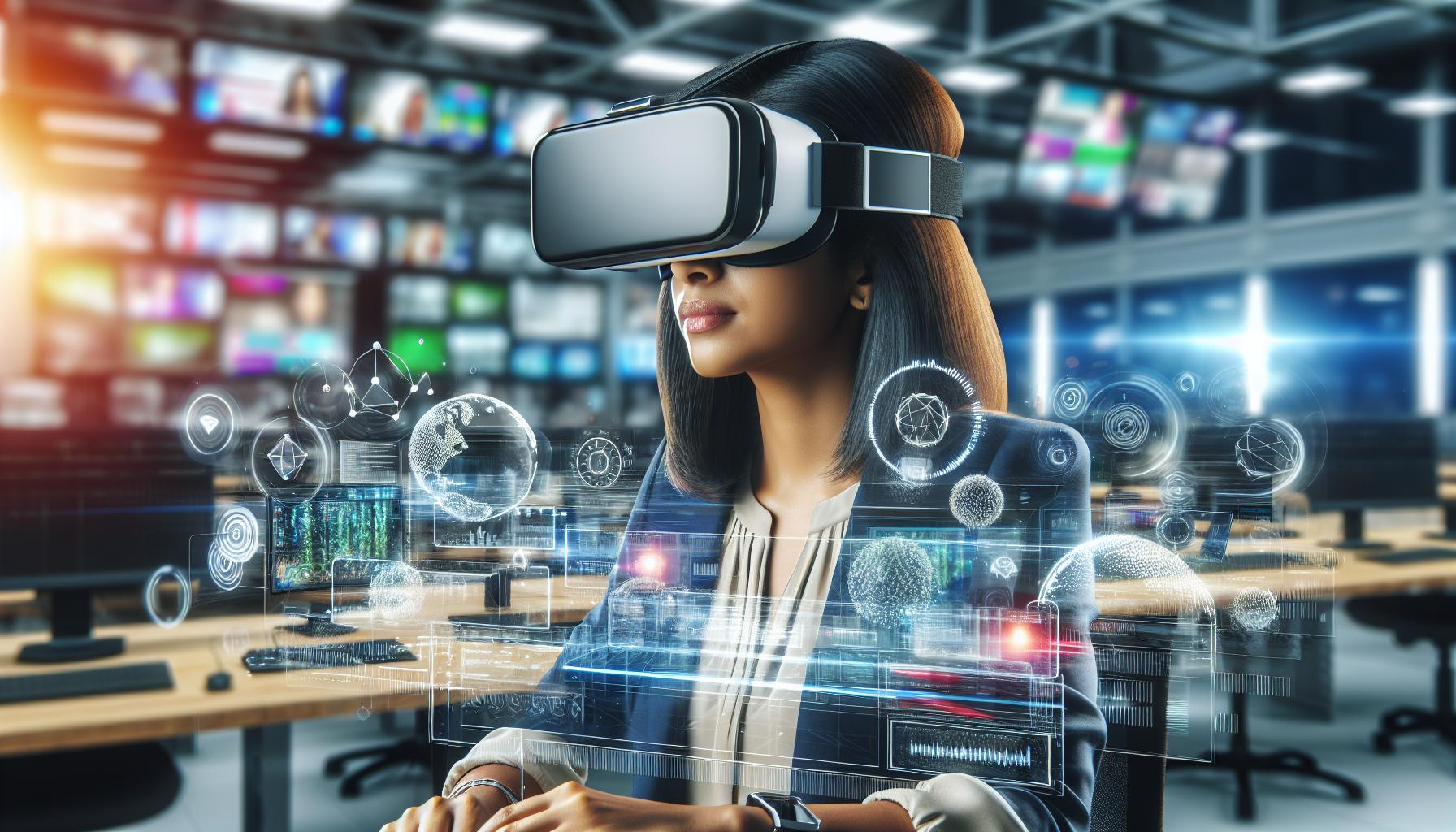Key Takeaways
- VR Industry Growth: The virtual reality market is set to grow rapidly, with an estimated compound annual growth rate (CAGR) of about 30% from 2023 to 2030, impacting various sectors like gaming, education, and healthcare.
- Innovative Hardware Advancements: Significant developments include lighter headsets, mixed-reality capabilities, and enhanced visual resolutions, improving user comfort and immersion.
- Transformative Storytelling: VR is changing how news is consumed by offering immersive experiences that foster empathy and deeper understanding of complex issues, utilizing techniques like 360-degree videos and interactive elements.
- Challenges Ahead: The VR news sector faces key challenges, including technical limitations such as hardware costs and internet access, as well as ethical concerns around privacy, misinformation, and bias in storytelling.
- Emerging Technologies: Innovations like artificial intelligence and haptic feedback are expected to shape the future of VR news, enhancing content creation and user interaction while improving engagement and transparency.
- Importance of Staying Informed: Keeping up with virtual reality news is crucial for enthusiasts and professionals to understand trends and adapt to the evolving landscape of immersive experiences.
Virtual reality is no longer just a futuristic concept; it’s rapidly transforming how people interact with technology and each other. As advancements in VR hardware and software emerge, the landscape is shifting, offering exciting possibilities across various sectors. From gaming to education and healthcare, virtual reality is making waves and capturing attention.
Keeping up with the latest virtual reality news is essential for enthusiasts and professionals alike. With new developments happening almost daily, understanding these trends can provide valuable insights into the future of immersive experiences. This article dives into the most significant updates in the VR world, showcasing innovations and breakthroughs that are shaping how we perceive reality.
Virtual Reality News
Virtual reality (VR) news encompasses the latest updates, innovations, and trends shaping the VR landscape. Various sectors, including gaming, education, and healthcare, are experiencing significant advancements through VR technology. Companies like Meta, HTC, and Valve lead hardware development, while software innovations introduce new applications and immersive experiences.
Recent breakthroughs in VR hardware include lightweight headsets, improved display resolutions, and advanced tracking systems. For instance, Meta’s Quest 3 features a mixed-reality capability that blends digital content with the physical world. This integration enhances user engagement and creativity in applications ranging from art design to virtual collaboration.
On the software front, VR platforms focus on expanding user interaction, offering experiences such as lifelike simulations for training and realistic environments for gaming. Educational institutions adopt VR for immersive learning experiences, allowing students to engage with historical events or complex scientific concepts in a three-dimensional space.
Staying informed about virtual reality news is crucial for enthusiasts and professionals. Emerging trends, such as social VR and the metaverse, highlight the potential for enhanced social interactions and new economic opportunities. Keeping up with industry developments ensures individuals and organizations remain competitive in a rapidly evolving landscape.
Latest Developments In Virtual Reality

The virtual reality landscape is witnessing significant advancements that shape various industries. Key players are making strides in hardware and software, enhancing user experiences across the board.
Industry Innovations
- Lightweight Headsets: Recent innovations include lighter and more comfortable headsets from companies like Meta and HTC, improving user comfort during extended use.
- Mixed-Reality Features: Meta’s Quest 3 has introduced advanced mixed-reality features, allowing users to interact with both virtual elements and their physical surroundings seamlessly.
- Enhanced FOV and Resolution: VR hardware is evolving with increased field of view (FOV) and higher resolutions, which significantly enhance visual fidelity and immersion.
- Cross-Platform Compatibility: Many new VR platforms focus on cross-device functionality, enabling users to connect and interact across different VR systems.
- Meta’s Vision for the Metaverse: Meta recently outlined its vision for a comprehensive metaverse, emphasizing immersive social interactions and content creation tools.
- HTC’s New VR Solutions: HTC unveiled its latest VR solutions aimed at enterprise applications, highlighting the growing interest in VR for training and simulation.
- Valve’s Software Updates: Valve announced significant updates to its VR platform, featuring new tools for developers to create immersive and interactive experiences.
- Educational VR Initiatives: Several educational institutions announced partnerships with VR companies to integrate immersive learning into their curriculums, showcasing VR’s potential in education.
Impact Of Virtual Reality On News Consumption

Virtual reality (VR) significantly alters how audiences consume news, creating immersive experiences that enhance engagement and understanding. These changes foster new ways for news organizations to connect with their viewers.
Changes In Audience Engagement
VR transforms audience engagement by immersing users in news stories. Viewers can interact with 360-degree videos, providing a sense of presence that traditional media does not offer. This immersion fosters empathy, allowing users to experience events from various perspectives. For example, a VR documentary about a humanitarian crisis can place viewers in the field, encouraging a deeper emotional connection to the subject matter. News outlets, such as The New York Times and BBC, have implemented VR content, successfully attracting younger audiences seeking innovative storytelling methods.
Enhancing Storytelling Techniques
VR enhances storytelling techniques by allowing journalists to create more dynamic narratives. By integrating visual elements with auditory experiences, stories can unfold in compelling ways. For instance, interactive elements such as clickable hotspots enable users to explore related information or perspectives while watching content. This technique provides greater context to complex issues, promoting comprehensive understanding.
Moreover, organizations like The Guardian utilize VR to report on difficult topics such as climate change, placing viewers directly in affected environments. This approach encourages informed discussions and aligns with journalistic goals of transparency and comprehensive reporting. VR’s potential to deliver news in immersive formats paves the way for innovative methods in journalism.
Challenges Facing Virtual Reality News

Virtual reality news faces several significant challenges that impact its development and effectiveness. This section highlights technical limitations and ethical considerations that shape the landscape of VR journalism.
Technical Limitations
Technical limitations hinder the widespread adoption of VR news. Infrastructure constraints affect distribution capabilities; many users lack access to high-speed internet necessary for streaming high-quality VR content. Hardware requirements pose another barrier; users may find VR headsets to be costly, which reduces overall accessibility.
Software challenges also play a role; developing immersive VR news experiences requires advanced programming skills and substantial resources. Production limitations exist as well; creating engaging content involves significant time and investment in specialized equipment.
User experience presents a critical issue. Users may experience motion sickness or discomfort during prolonged use, reducing engagement with VR news stories. Compatibility issues across platforms further complicate the user experience. With various VR ecosystems in place, ensuring seamless integration can be challenging.
Ethical Considerations
Ethical considerations significantly impact the development of VR news. Issues surrounding privacy arise as VR technologies enable more immersive and invasive storytelling. Journalists must navigate complex questions regarding consent; involving real people and sensitive situations can blur ethical lines.
The potential for misinformation also poses a challenge. The immersive nature of VR can create a sense of authenticity that may lead audiences to accept content as fact without questioning its validity. Journalists must prioritize accuracy and transparency to maintain credibility in a fast-evolving medium.
Bias in storytelling can skew the audience’s perception of events. Creators must ensure that their narratives represent diverse perspectives and do not reinforce stereotypes or misinformation. As VR news continues to grow, establishing ethical guidelines will be essential to preserve journalistic integrity.
Future Trends In Virtual Reality News
The future of virtual reality (VR) news is poised for significant transformations driven by technological advancements and industry predictions. Observers anticipate a landscape marked by innovative applications and improved user experiences.
Predictions For The Industry
Experts predict that the VR news sector will undergo rapid expansion and diversification. Current estimates project that the VR market will grow at a compound annual growth rate (CAGR) of approximately 30% from 2023 to 2030. Key industry players, such as Meta and BBC, are likely to enhance their VR offerings by investing in immersive storytelling techniques. Organizations may experiment with interactive narratives, enabling audiences to engage with news stories on a deeper level. Additionally, as 5G technology becomes more widely available, it will facilitate smoother streaming of high-quality VR content, further increasing accessibility and user engagement. The rise of personalized content tailored to individual preferences could also shape news consumption patterns, leading to the development of customized VR news feeds.
Emerging Technologies
Emerging technologies will play a vital role in shaping the future of VR news. Artificial intelligence (AI) is expected to enhance content generation, enabling automated storytelling and real-time news updates. AI could streamline the production of 360-degree videos, making it easier for media outlets to create immersive experiences. Furthermore, advancements in haptic feedback technology are likely to enable users to physically interact with virtual environments, enhancing emotional connections to news stories. Augmented reality (AR) integration may blur the lines between VR and traditional mediums, allowing viewers to access layered information in real-time during live events. Blockchain technology may also enhance transparency and trust in VR journalism by securely documenting content sources and ownership, addressing concerns about misinformation.
Virtual Reality Continues
The landscape of virtual reality continues to evolve rapidly with exciting advancements that reshape technology and news consumption. As companies push the boundaries of VR hardware and software, users can expect more immersive experiences that enhance engagement and understanding. The integration of VR in various sectors, especially journalism, offers innovative storytelling methods that captivate audiences and provide deeper insights into complex issues.
With the anticipated growth in the VR news sector driven by technological innovations and increased accessibility, staying informed about these developments is crucial. As VR becomes more mainstream, it promises to transform how individuals interact with information and each other, paving the way for a more connected and informed society.